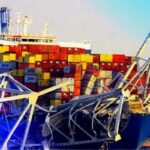Heroic Actions Amid Tragedy Baltimore Bridge Collapse

The collapse of Baltimore’s Francis Scott Key Bridge following a cargo ship collision resulted in two fatalities, with four individuals still missing and presumed dead. Despite the tragic outcome, authorities and marine experts acknowledge that the situation could have been far worse. Several factors, including swift responses and fortunate circumstances, contributed to lives being saved amidst the disaster.

Swift Response and Emergency Communication
Quick thinking by the ship’s crew and port authority police played a crucial role in minimizing casualties. The crew of the Singapore-tagged Dali container ship issued a mayday distress call after losing propulsion, providing authorities with approximately 90 seconds to halt traffic on the bridge. Police swiftly coordinated traffic shutdowns, but tragically, the collapse occurred seconds later.
Unsung Heroes: Bridge Attendants and Emergency Services
Bridge attendants who promptly halted traffic are hailed as unsung heroes. Their rapid response prevented additional vehicles from crossing the bridge, potentially saving numerous lives. Despite the limited timeframe, their actions exemplify the importance of effective emergency protocols and communication systems.
Efforts of Seafarers and Maritime Authorities
Seafarers aboard the Dali container ship reportedly made efforts to avoid the collision, dropping anchor to mitigate the impact. The mayday call alerted authorities, facilitating swift responses and rescue efforts. Additionally, the Coast Guard’s rapid deployment and thorough search and rescue operations helped retrieve survivors from the water.

Timing and Training: Factors in Disaster Mitigation
The timing of the incident, occurring during off-peak hours with minimal traffic, likely reduced the number of casualties. Furthermore, ongoing training and technological advancements in the maritime industry contribute to disaster mitigation. Crews undergo rigorous training for various emergency scenarios, ensuring preparedness and effective response during crises.
Importance of Technology and Safety Systems
Technological advancements, including GPS and automation, enhance safety measures aboard ships. Improved safety systems and regular systems checks help prevent and mitigate potential disasters. The integration of advanced technology and rigorous safety protocols underscores the commitment to maritime safety and disaster preparedness.
While the Baltimore bridge collapse is a tragic event, the heroic actions of professionals and the implementation of emergency protocols highlight the importance of preparedness and swift response in mitigating the impact of such disasters.























